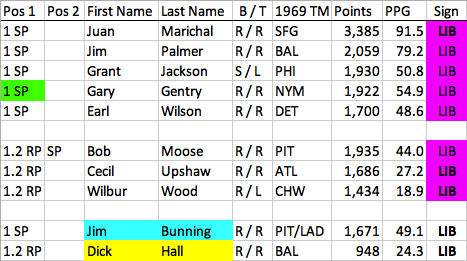1969 Fantasy Astrology Recap
View the 1969 FABL Lineups Here!
While I was building the Fantasy Astrology Lineups for 1969, I couldn’t seem to shake a feeling of dread. 1969 was the culmination of the expansion era, with not one, not two, but FOUR teams celebrating their inaugural seasons: the Montreal Expos, the San Diego Padres, the Kansas City Royals, and the short-lived Seattle Pilots, who would move to Milwaukee and become the Brewers the following year. But this influx of new players means that when I continue reverse-chronologically to 1968, the pool of available players will shrink by approximately 80. (That’s eight position players, five starting pitchers, four relievers, and a smattering of bench bats, all multiplied by four.) We’ll see if I’m able to build serviceable lineups for all 12 signs next time, but for now, let’s enjoy the last season (reverse-chronologically speaking) when MLB consisted of 24 teams.
Once again, as was the case for five of the previous six (reverse-chronological) seasons, Aries took home the fantasy points crown. And once again, Pete Rose (2,425 / 15.5) led his sign in fantasy points for batters while playing the outfield, even though I cheated him back to his original position of second base. This opens up an outfield spot for Willie Davis (1,667 / 12.9) to play alongisde Rusty Staub (2,181 / 13.8) and Reggie Smith (2,055 / 14.4), which keeps us from having to use real-life NL Rookie of the Year Ted Sizemore (1,275 / 8.0) at the keystone. A new Aries ace emerged this year, with Denny McLain (3,218 / 76.6) outscoring familiar faces Phil Niekro (3,099 / 77.5) and Don Sutton (2,361 / 57.6). Meanwhile, Twins closer Ron Perranoski (2,066 / 27.5) was not only 1969’s top relief pitcher, but also the only reliever to break the 2,000-points barrier.
While Virgo would go on to lead the FABL in 1970 fantasy points, the Flowers had to be content with second place overal in 1969. This still put them in the Earth Division lead, even though runner-up Taurus had the league’s best pitcher: Dodgers ace Bill Singer (3,516 / 85.8) leads in total points, but Scorpio Bob Gibson (3,432 / 98.1) had a far superior points-per-game average. (But just wait till you see what he does in 1968.) Next in line for Negative Polarity pitchers was the 22-year-old Larry Dierker (3,331 / 85.4), who surprisingly outpitched his Virgo sign-mate, the legendary Garylord Perry (3,134 / 78.4). Speaking of legendary, Frank Robinson (2,414 / 16.3) and Joe Morgan (1,947 / 13.2) led the Virgo offensive attack. These two again fell behind the top two Taurus batters Reggie Jackson (2,782 / 18.3) and Tony Perez (2,424 / 15.2), proving once again that consistency is better than star power.
The top positive pitcher was Gaylord Perry’s real-life Giants teammate Juan Marichal (3,385 / 91.5), who helped lead Libra to first place in the Air Division. This victory came despite the Scales not having a single 2,000-point batter: Tommy Harper (1,854 / 12.5), who played second base, third base, and center field for the Pilots, came the closest. They did however feature the Positive Polarity’s top rookie, starting pitcher Gary Gentry (1,922 / 54.9), who was a big part of the Miracle Mets, along with their Scorpio ace Tom Seaver (3,279 / 91.1), Capricorn Jerry Koosman (2,645 / 82.7), and a pair of Leo outfielders Cleon Jones (1,933 / 14.1) and Tommie Agee (1,878 / 12.6).
Leo also had the top PP batter in Washington Senators left fielder/first baseman Frank Howard (2,613 / 16.2) – who had the same exact positional profile of his sign-mate Carl Yastrzemski (2,443 / 15.1). But the top overall batter in 1969 belonged to the Water Division-winning Cancer Crabs: Twins corner infielder Harmon Killebrew (2,869 / 17.7). Killebrew’s batting stance is rumored to be the inspiration behind the MLB logo, which was created the previous year in 1968. You could do worse than 1969’s real-life MVP, who reached the 40 home run plateau eight times.
Of course, if you follow positional eligibility rules to the letter, Pisces comes out on top, thanks to the outfield tandem of Bobby Bonds (2,545 / 16.1) and Jim Wynn (2,390 / 16.0), of the Giants and Astros, respectively. The Fish also had a player who was both the top Negative Pole rookie AND relief pitcher: Reds closer Wayne Granger (1,999 / 22.2), who was the first pitcher to appear in 90 games. Incidentally, the runner-up to both the NP Rookie of the Year and Relieble Reliever was California Angels closer Ken Tatum (1,750 / 38.9), of the Taurus Bulls.




